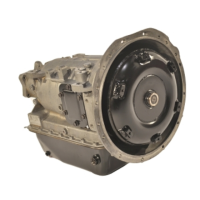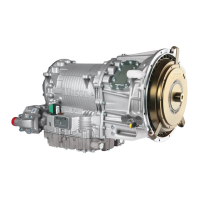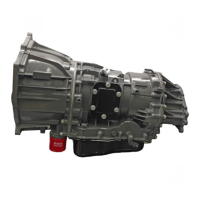Copyright © 1996 General Motors Corp. 3–19
PREVENTIVE MAINTENANCE
PREVENTIVE MAINTENANCE
f. Installation of Output Shaft Bearing
and Snapring
(1) Clean the bearing bore. Make sure
snapring 9 (Foldout 12,A) is seated in its groove and is
not damaged.
(2) Using tool J 24446, install bearing 4
(Foldout 12,B) into the transmission housing. The tool
will seat the bearing squarely against snapring 9 (Fold-
out 12,A).
(3) Install snapring 5 (Foldout 12,B), bev-
eled side outward, into its groove in the transmission
housing. Be sure the snapring is fully expanded.
g. Installation of Output Seal (Foldout 12,B)
(1) Refer to Paragraph 4-6f for preparation
of seal 6.
(2) Start the seal, lip first, squarely into the
rear bore of the transmission housing.
(3) Using installer tool J 23631, drive the
seal into the housing until the installer seats against the
housing.
h. Installation of Output Flange
(1) Lubricate the splines of the shaft and out-
put flange and install the output flange onto the output
shaft.
(2) Install the flange retainer washer into the
flange. Retain the flange to the output shaft with one
1
⁄2-20 x 1
1
⁄2 inch Type BH patch bolt (P/N 29510838)
and one
17
⁄32 inch hardened plain washer (P/N 9411417)
(Figure 3–9). Do not use the earlier style bolt. Tighten
the bolt to 102–121 lb ft (138–164 N·m).
(3) Connect the vehicle drive shaft to the
transmission output flange. (See vehicle installation
manual for alignment procedure, if required).
3–17. TROUBLESHOOTING — BEFORE
REMOVAL OR OPERATION OF
TRANSMISSION
a. Visual Inspection. Do not operate the vehicle
prior to completing the procedures described in this
Paragraph. Inspect for transmission fluid leakage. Vi-
sually inspect all splitlines, connections, valve bodies,
fluid level indicator tube, and plugs and hoses at the
transmission and cooler. Fluid leakage at splitlines
may be caused by loose mounting bolts or defective
gaskets. Tighten all bolts, plugs, and connections
where leakage is found. If mounting bolts are tight and
fluid continues to leak, install a new gasket. Fluid leak-
ing from the fluid level indicator tube may be caused
from foaming and aerating (Paragraph 3–3b). Check
linkage (Paragraph 3–12).
b. Vacuum Modulator Check
(1) Vacuum diaphragm leak check. Insert
a pipe cleaner into the vacuum modulator connector
pipe as far as possible and check for the presence of
transmission fluid. If fluid is found, replace the modu-
lator.
NOTE:
Gasoline or water vapor may settle in the vacuum
side of the modulator. If this is found without the
presence of transmission fluid, the modulator need
not be changed.
(2) Atmospheric leak check. Apply a lib-
eral coating of soap bubble solution to the vacuum
connector pipe seam, crimped upper-to-lower housing
seam, and threaded screw seal. Using a short piece of
rubber tubing, apply air pressure to the vacuum pipe
by blowing into the tube and observe for leak bubbles.
If bubbles appear, replace the modulator.
NOTE:
Do not use any method which will produce more
than 6 psi (41 kPa) air pressure, as pressure over 6
psi (41 kPa) may damage the modulator.
CAUTION:
Do not use a hammer or mallet to drive the flange
onto the output shaft. Hammering the flange
onto the shaft could damage the internal, caged
roller bearings and output bearing.

